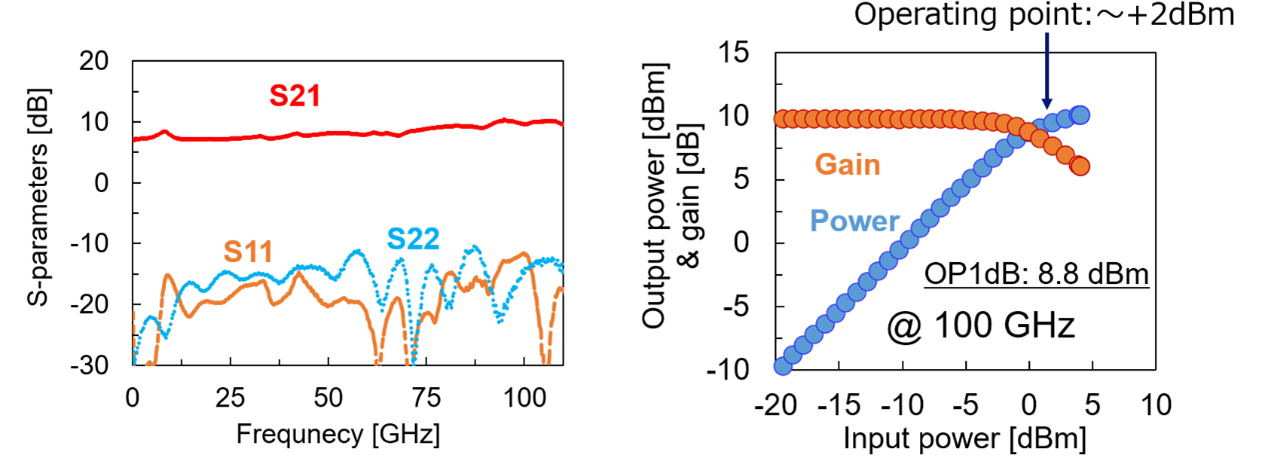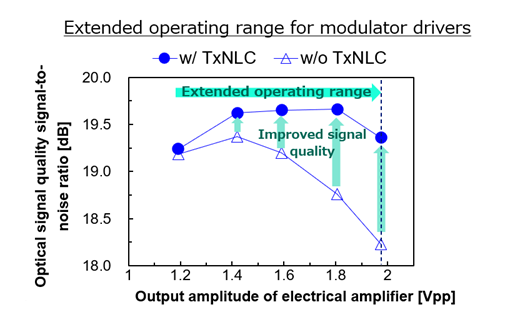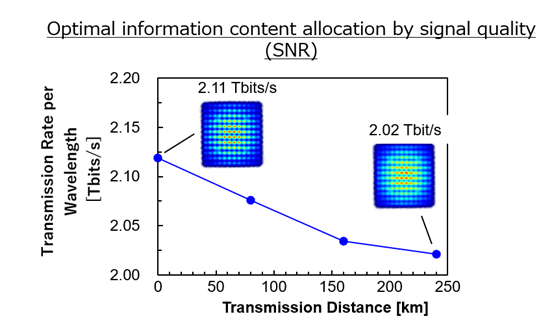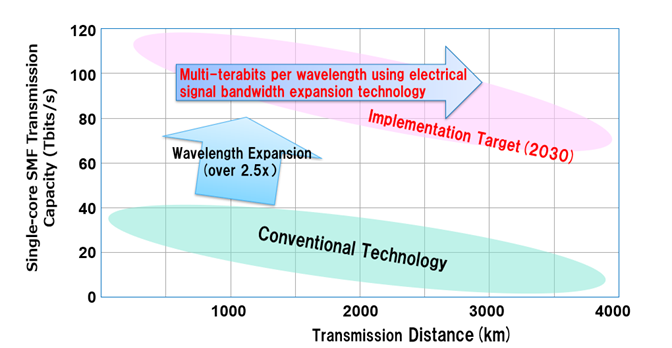Microsoft ends support for Internet Explorer on June 16, 2022.
We recommend using one of the browsers listed below.
- Microsoft Edge(Latest version)
- Mozilla Firefox(Latest version)
- Google Chrome(Latest version)
- Apple Safari(Latest version)
Please contact your browser provider for download and installation instructions.
September 22, 2022
NTT Achieves the World's Fastest Optical Transmission of over 2 Tbits/s Per Wavelength
A Large Capacity Communication Network Technology to Support IOWN & 6G
Tokyo – September 22, 2022 – NTT Corporation (President and CEO: Akira Shimada, "NTT") has succeeded in the world's fastest1 optical transmission experiment of digital coherent2 optical signals exceeding 2 Tbits/s per wavelength.
In this experiment, NTT developed an ultra-wideband baseband amplifier IC3 module and digital signal processing technology that can compensate for distortion in the optical transceiver circuit with extremely high accuracy. We then demonstrated the transmission and reception of digital coherent optical signals exceeding 2 Tbits/s per wavelength and succeeded in a 240 km optical amplification repeater transmission experiment of an optical signal of 2.02 Tbits/s.
This result suggests that further scalability of digital coherent optical transmission technology can achieve both a large capacity per wavelength―which is more than double the conventional level―and a long transmission distance. This core technology is expected to lead the development of the All-Photonics Network of the IOWN4 and 6G initiatives.
Fig 1: Our Result Compared with Conventional Technology1

Communication traffic is predicted to increase in the future due to the proliferation of 5G services that will address various social issues and the development of IOWN and 6G services. The All-Photonics Network, which is IOWN's backbone optical communication network, must cost-efficiently achieve even greater capacity. In the future, to economically transmit ultra-high-speed Ethernet signals of 1.6 terabits per second or more over long distances, we hope to achieve long-distance optical transmission of more than 2 Tbits/s per wavelength by expanding the transmission capacity per optical signal wavelength and the signal symbol rate6, optimizing the amount of information per symbol.
To expand the transmission capacity per wavelength, it is necessary to overcome the speed limit of silicon CMOS7 semiconductor circuits. To date, NTT has been researching and developing optical transmission systems and integrated devices using band doubler technology that overcomes the speed limit of silicon CMOS using AMUX and has succeeded in generating optical signals with a symbol rate exceeding 100 gigabaud8. However, to realize optical transmission of multi-terabits per second or more, it is necessary to achieve both a wider bandwidth and higher output of the electrical amplifier (driver amplifier for driving the optical modulator) in the optical transceiver. In addition, as speeds continue to increase, there is a demand for technology that can compensate for deviations from the ideal optical transmission/reception circuit (differences in signal path length, loss variations due to signal paths, etc.) with extremely high accuracy.
Now, for the first time in the world, we have demonstrated the transmission and reception of a digital coherent optical signal exceeding 2 Tbits/s per wavelength (Fig. 1, left) and successfully conducted an optical amplification repeater transmission experiment of 2.02 Tbits/s over 240 km (Fig. 1, right). Our team achieved this feat through the advanced fusion of NTT's original ultra-wideband baseband amplifier IC module and ultra-high-precision digital signal processing technology.
An ultra-wideband baseband amplifier IC module
NTT has been researching and developing an ultra-wideband baseband amplifier IC3 based on InP-based heterojunction bipolar transistor (InP HBT) technology9 and equipped with a 1mm coaxial connector that supports frequencies up to 110 GHz. We have succeeded in creating a module that is mounted in a package and has ultra-wideband performance (Figure 2, left) and sufficient gain and output power (Figure 2, right). Presently, we have applied this baseband amplifier IC module as a driver amplifier for driving an optical modulator.
 Fig. 2: Frequency characteristics and input/output power characteristics of amplifier IC modules
Fig. 2: Frequency characteristics and input/output power characteristics of amplifier IC modules
An ultra-high-precision optical transceiver circuit distortion compensation technology based on digital signal processing technology
NTT has developed an ultra-wideband baseband amplifier IC module based on InP HBT technology enabling us to generate ultra-high-speed signals. However, when it is used as a driver amplifier for driving an optical modulator, it must operate in a high-power output range, so the nonlinearity of the driver amplifier output (where the output power is not proportional to the input power) becomes a problem and the optical signal quality (signal-band-noise ratio) deteriorates. In addition, with ultra-high-speed signals, degradation of signal quality becomes noticeable due to deviation from the ideal inside the optical transceiver.
In this experiment, NTT's world-leading digital signal processing technology compensated for non-linear distortion generated in the modulator driver and the deviation from the ideal inside the optical transceiver with ultra-high precision. We have expanded the operating range of the IC module and succeeded in improving the optical signal quality (Fig. 3). Using this high-quality ultra-high-speed optical signal, we conducted an optical amplification repeater transmission experiment. The PCS-144QAM5 method, which optimizes the distribution of signal points, was applied to an ultra-high-speed optical signal of 176 gigabaud to generate an optical signal of up to 2.11 Tbits/s. Furthermore, we succeeded in transmitting an optical signal of 2.02 Tbits/s over 240 km using technology that allocates the optimal amount of information according to the transmission distance (Fig. 4).
 Fig. 3: Expansion of the operating range of ultra-wideband baseband amplifiers by ultra-high-precision distortion compensation for optical transceiver circuits
Fig. 3: Expansion of the operating range of ultra-wideband baseband amplifiers by ultra-high-precision distortion compensation for optical transceiver circuits
 Fig. 4: Experimental result of optical amplification repeater transmission of more than 2 Tbits/s per wavelength
Fig. 4: Experimental result of optical amplification repeater transmission of more than 2 Tbits/s per wavelength
This technology is expected to enable highly reliable transmission of large-capacity signals by multiplexing optical signals exceeding 2 Tbits/s per wavelength. In particular, technology for increasing the modulation speed of optical signals not only contributes to increasing the capacity per wavelength, but also, as shown in Fig. 5, can generate large-capacity signals when combined with wavelength resource expansion technology10. Our technology is also expected enable long-distance transmission. NTT will promote research and development by continuing the integration of its own device technology, digital signal processing technology, and optical transmission technology toward the realization of an All-Photonics Network of the IOWN and 6G initiatives.
Fig. 5: Impact of this Result on Future Development

1According to NTT's research as of Sept. 2022.
2Digital coherent technology is a transmission method that combines digital signal processing and coherent reception. Coherent reception is a technology that makes it possible to receive the amplitude and phase of light by causing interference between a light source placed on the receiving side and the received optical signal. Modulation methods such as polarization multiplexing and phase modulation improve frequency utilization efficiency, and high-precision optical signal compensation using digital signal processing and coherent reception achieve a significant improvement in reception sensitivity.
3An ultra-wideband baseband amplifier IC (Integrated Circuit) developed by NTT that has the widest bandwidth in the world. InP-HBT realizes an amplifier IC that applies our unique high-precision circuit design technology and new circuit architecture technology that enables broadband. NTT News Release: "Achievement of Amplifier IC with World's Widest 241 GHz Bandwidth: Expected as General-Purpose Ultra: High-Speed Device Technology for Next-Generation Data Centers and Beyond 5G"
https://group.ntt/jp/newsrelease/2019/06/03/190603b.html
4NTT Technology Report for Smart World: What's IOWN?:
https://group.ntt/jp/newsrelease/2019/05/09/190509b.html
5PCS (Probabilistic Constellation Shaping) is a technology that reduces the signal-to-noise ratio requirements for signal transmission by optimizing the distribution and arrangement of signal points based on information theory. QAM (Quadrature Amplitude Modulation) is a modulation method that carries information on both the amplitude and phase of signal light, and 144QAM has 144 signal points. By applying PCS technology to the QAM system, it becomes possible to optimize the signal quality according to the transmission path conditions.
6The number of times the optical waveform switches in one second. A 176 gigabaud optical signal transmits information by switching the optical waveform 176 billion times per second.
7Complementary metal oxide semiconductors are used to realize large-scale functions such as CPU as a structure to realize a semiconductor integrated circuit. This type of circuit is often used for transmission and reception of large-capacity optical transmission because the amount of signal is large. Although the speed is increasing due to miniaturization, compound semiconductors are superior in terms of high speed.
8NTT News Release: "World's First Successful Wavelength Multiplexing Optical Transmission Experiment for Long-distance Transmission of 1 Tbit/s per Wavelength: A Future Large-Capacity Communication Network Technology Supporting the Spread of IoT and 5G Services"
https://group.ntt/jp/newsrelease/2019/03/07/190307a.html
9A heterojunction bipolar transistor using indium phosphide, a group III-V semiconductor. It is a transistor with excellent speed and withstand voltage.
10NTT News Release: "World's First Success in Broadband Optical Amplification Relay Transmission Using Optical Parametric Amplifier: Capable of More than Twice the Capacity of Conventional Optical Amplifiers"
https://group.ntt/jp/newsrelease/2021/01/28/210128b.html
About NTT
NTT believes in resolving social issues through our business operations by applying technology for good. An innovative spirit has been part of our culture for over 150 years, making breakthroughs that enable a more naturally connected and sustainable world. NTT Research and Development shares insights, innovations and knowledge with NTT operating companies and partners to support new ideas and solutions. Around the world, our research laboratories focus on artificial intelligence, photonic networks, theoretical quantum physics, cryptography, health and medical informatics, smart data platforms and digital twin computing. As a top-five global technology and business solutions provider, our diverse teams deliver services to over 190 countries and regions. We serve over 75% of Fortune Global 100 companies and thousands of other clients and communities worldwide. For more information on NTT, visit https://www.rd.ntt/e/.
###
NTT and the NTT logo are registered trademarks or trademarks of NIPPON TELEGRAPH AND TELEPHONE CORPORATION and/or its affiliates. All other referenced product names are trademarks of their respective owners. © 2022 NIPPON TELEGRAPH AND TELEPHONE CORPORATION
NTT Contact
NTT
NTT Science and Core Technology Laboratory
Group, PR Division
TEL +81 046-240-5157
science_coretech-pr-ml@hco.ntt.co.jp
Media Contact
Information is current as of the date of issue of the individual press release.
Please be advised that information may be outdated after that point.
NTT STORY
WEB media that thinks about the future with NTT









